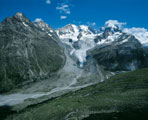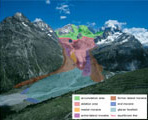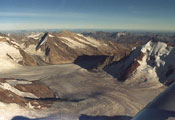 |
|
|
|
|
|
|
Glacier ice covers as much as 10% of the earth’s land surface at the present time and covered about three times as much during the ice ages. In geological terms we are living in a glacial era that began in Antarctica perhaps 40 million years ago. However, the latter stages of this era have included many alternations between periods. A period of full glaciation, when up to 30% of the land in the northern hemisphere was covered, ended as recently as 10,000 years ago, and a return to such conditions may be expected in a few thousand years time. At present, all but about one per cent of the total glacier ice is in areas remote from normal human activities, the great ice sheets of Greenland and Antarctica. Thus it is not surprising that the relatively small glaciers in mountain areas were the first to attract attention. |
|
In these globale maps you can find the present day distribution of glaciers
and ice sheets. |
||
|
Source: Glaciers by Hambrey and Alean |
|
Glaciers are snow-, firn- and icemasses, that flow from an accumulation area with mass supply to an ablation area with mass loss. Glaciers belong to the hydrosphere in contrast to permafrost that belongs to the lithosphere. |
||
 |
2a and b - Vadret da Tschierva is a typical mountain glacier. The upper white zones of the glacier are the accumulation area and the grey ones are the ablation area. In front of the glacier is the glacier forefield, which the glacier had covered in previous years. On each side the moraines from the „little ice age“ are easily recognizable. (148K and 284K) |
 |
|
3 - Grosser Aletschgletscher, Konkordiaplatz. Confluence area of four accumulation basins feeding a large valley glacier. The thickness at the Konkordiaplatz is around 900 meters. (112K) |
||
|
Description of glaciers can be found in the 11th century Icelandic literature, but the fact that they move does not appear to have been recognized until 500 years later. Since that time, the problem of how large, ice masses can flow has been debated by many scientists. Altmann (1751) and de Saussure (1779-1796) correctly recognized that gravity is the driving factor of glacier motion. At that time they thought that the movement consisted entirely of the ice sliding over its bed. Many glaciers do slide but, in addition, the ice itself can flow, somewhat like a very viscous fluid.
|
|
|
|
Paterson W S B, The physics of glaciers, 1994 Hambrey M and Alean J, Glaciers, 1992 |
|||
29 August 2011 |
||
| |
||
